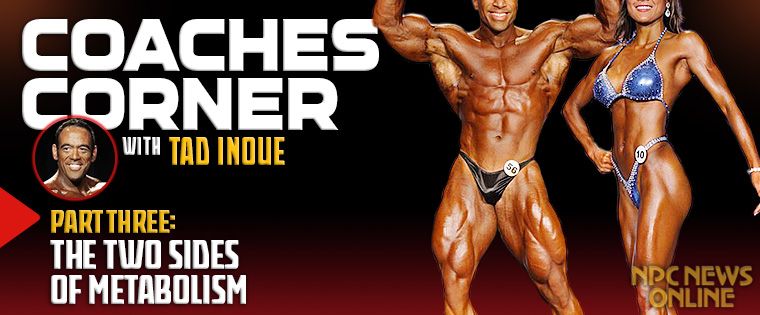Your body’s metabolism has two distinct sets of processes that work synergistically and will either enable you to accomplish your body goals or hinder you. This metabolic duality sets the internal stage for you to have either a high or low caloric need each day. Many of the components within your lifestyle will contribute to the speed of your overall metabolism and can always be classified within one of these processes. In order to master your metabolism, you will need to understand both internal processes and what factors within your lifestyle can influence each of them.
The most obvious factors include:
• Genetic heritage
• Lean body mass
• Activity levels
• Dietary habits
However, there are also other very important factors that can heavily influence your body’s metabolism, such as:
• Timing of nutrients during the day
• Timing of activities
• Intensity and duration of physical activities
• Stress levels
• Long-term dieting protocols
• Excessive activities over long periods of time
All of these factors have an impact on the speed of your metabolism in ways that may contradictory at first.
Throughout the years, my clients often express concerns about the speed of their metabolisms. I have consistently heard: “I am going to be a tough client, my metabolism is slow and I gain fat easily.” While sometimes this has been true, typically they didn’t lose fat quickly because factors in their lifestyles were not conducive to faster metabolisms.
To begin, it’s important to understand what metabolism is and to define the two processes that make it up. Metabolism is the building up or breaking down of body tissues and energy stores in order to generate fuel for the body. With this definition of metabolism we can understand our body’s chemical processes more simply in two areas, anabolic reactions and catabolic reactions, or simply anabolism and catabolism.
ANABOLISM
Your body’s anabolic processes are a set of constructive metabolic pathways that build up organs, tissues or cells. This kind of constructive metabolism focuses on building, repairing, and maintaining body tissues thru the conversion and storage of macronutrients such as carbohydrates, proteins, and lipids.
If you are a bodybuilder or figure competitor, anabolism is very important because it enables you to repair muscle tissues after workouts, maintain healthy skin, hair and nails, and build muscle in certain circumstances. However, it can also mean the storage of excess glycogen in muscle and liver tissue in order to fuel workouts and activities, or it can mean the storage of excess energy materials as body fat.
So, how can we influence anabolism within our body so that our metabolism is building muscle, repairing tissues, and not storing excess body fat?
Ironically, the answer to greater anabolism – and a faster metabolism – is to eat more. This means eating appropriately for your energy needs and the repair and recovery processes of your body, and not becoming deprived of the nutrients that you require. Your diet should have the appropriate level of carbohydrates at planned times which makes sense for your activity schedule so that you are at your anabolic peak speed.
Factor 1: Carbohydrates
These days the word “carbohydrate” seems to be a bad word, and most people who are trying to lose fat and eat healthier try hard to minimize their carbohydrate intake. However, your metabolism is regulated by this energy nutrient, and can become depressed if you deny this clean-burning energy source for too long. Simply put, carbohydrates make your metabolism run faster, and a lack of them will cause your metabolism to conserve energy and slow down, making anabolism difficult to achieve.
Long-term caloric restriction can cause severe metabolic adaptations, and in some cases persistent metabolic slow down. So it is important to apply appropriate carbohydrate feeding so that your metabolism will adapt and speed up. Pumping up your body’s anabolism with rice, potatoes or pasta after weight training and other high intensity workouts will ensure that your metabolism stays primed, and your metabolic pathways don’t negatively adapt and slow down.
Watch out though! Most of the carbohydrate loading that many people do come from sources that can cause other hormonal reactions, such as increasing insulin to levels that can encourage fat storage. Your metabolism can adapt and become faster if you feed it correctly, but it will only respond within reason and only from high-quality nutrients.
Factor 2: Genetics
For many of us, our bodies will perform normally and within general guidelines. However, there are individuals who seem to operate outside these limits. For some, the speed of their metabolism seems to quicken at a pace that is above the norm, and for others their metabolism seems to be very sluggish. It is important to note that these cases tend to be exceptions and not the norm. Ninety-eight percent those who are concerned with metabolism have normal metabolic function.
Factor 3: Activity
Most physical exercise will speed up metabolism for several hours after the activity is performed. This effect is typically in relation to your lean body mass. Simply put, the more muscle you have, the more you can speed up your metabolism. In the end, your muscle mass and your daily activity level will be the biggest factors in determining how many calories your metabolism will require for its basic metabolic needs, and it will determine to what degree your metabolic rate can adjust if you speed it up or slow it down.
Too much activity, under certain circumstances, can slow your metabolism. In general, doing cardio and working out will increase caloric need, and thus produce an increase in metabolism. But too much activity while on a very caloric restrictive diet can cause your body to adapt in ways that slow down nutrient need over time. Your body is continually trying to balance caloric need with caloric expenditure, and will find ways to slow down tissue wasting by creating a balance with energy demand.
These slowing adaptations often result in several negative adaptations. Some adaptations that your metabolism may initiate could be a decrease in thyroid hormone output, a reduction in anabolic hormones, a reduction in lean tissue, an increase in catabolic reactions, and a systemic conservation of thermo reactions (a lowering of body heat). All of these adaptations are bad for metabolism and will contribute to severe slow down. Any adaptation your metabolism initiates will happen over time. The longer you put a stress on your body, the more likely it will find the quickest way to adapt.
Factor 4: Muscle
This one is simple – more muscle means a greater anabolic need. Muscle is the main tissue in your body that requires calories to exist. Just sitting at rest, you will have protein requirements and energy requirements to keep it functioning normally.
Creating lots of muscle means maximizing your anabolic drive system with nutrients. This means lots of energy and fuel components like carbohydrates, and it also means more recovery and maintenance materials like proteins. It will be impossible to build muscle if you don’t feed your metabolism with high-quality fuels – like rice and potatoes – and give it lots of building materials, such as lean meats and whey protein. The key to making this anabolic system support muscle synthesis is continual feeding throughout the day. Eating every two to three hours will help enable you to do this.
Building an effective anabolic metabolism is very calorie expensive. It will always take thirty-five hundred stored calories to make one pound of muscle or fat. This means that you just don’t put fat or muscle on your body without over consuming your basic needs. And conversely, you don’t burn off a pound without exceeding your caloric needs by this amount either.
Many of the anabolic reactions in your body can, in the long run, enable your metabolism to speed up. The keys to speeding up your metabolism with anabolism is to feed your metabolism with the appropriate energy and recovery nutrients, increase your physical activities without placing an unbalanced demand on your metabolism and caloric intake, and maximize your lean muscle mass so that your body’s metabolic need is higher. This is only half of our definition of metabolism though. We now need to look at catabolism and how it can affect your metabolism.
CATABOLISM
Catabolism is your body’s destructive metabolism and it is the other half our definition of metabolism. This side of your metabolism centers on the processes that produce energy for anabolism as well as all the energy required for all the other cellular processes in your body. Both anabolism and catabolism go hand-in-hand and function simultaneously; it is not possible for you to have one without the other.
The reason the relationship between anabolism and catabolism is so important, is because catabolism is responsible for the breakdown of basic fuels into a usable energy source (ATP) and it is this usable energy that makes anabolism possible.
So how do we use catabolism to help us in our efforts to speeding up our metabolic processes? You can’t directly use your body’s catabolic reactions to speed up your metabolism, but you can understand the dangers to your metabolism if you have too much tissue catabolism.
Dangers
Losing lots of scale weight quickly may seem like an ideal way to diet but in reality it can cause some potential setbacks down the road that can make your lifestyle and health miserable. As you take in fewer and fewer preferred energy materials like carbohydrates, your body will first prefer to break down lean tissue and extract the valuable energy it needs from your muscle instead of freeing up lipids from stored body fat. This is a protective mechanism that automatically lowers burn rate by reducing lean muscle mass and thus reducing your overall daily caloric need.
Over long periods of time, lean tissue wasting can lead your body to a point where your caloric need is so low that over eating your daily demand is almost a certainty, if you follow your appetite. There is a delicate balance between ideal tissue wasting and a healthy amount of fat loss that won’t set off your body’s defensive adaptations. In general, most consider one pound of scale weight loss a week for women and one to two pounds of scale weight lost per week for men to be safe amounts.
It is important to note that these numbers are only general guidelines, and they don’t include initial water loss that many people experience when they start up a clean eating program.
Metabolic Lifestyle Guidelines
Finally, we can assemble some guidelines to follow based on what we know about our metabolic anabolism, as well as list a few things to follow if we want to safe guard our metabolism from any kind of slow down
• Eat high-quality carbohydrates to fuel high intensity activities
• Eat high-quality protein to enable lean tissue building
• Eat small meals often
• Work out regularly with high intensity resistance training to add muscle
• Do your cardio regularly
• Don’t over-do your workouts or cardio sessions, this can result in lean tissue wasting
• Mediate quick scale weight loss, this could be a sign of lean tissue wasting
As you set up your winning strategy for your body, remember these metabolic lifestyle guidelines and remember that your metabolism has a dual nature that you must work with in order to accomplish your body goals.
 ABOUT TAD INOUE
ABOUT TAD INOUE
Tad Inoue has been a competitive bodybuilder for over 27 years. He has dedicated his life’s work and studies to bodybuilding, figure, physique and bikini competition prep and coaching. Tad has a background in nutrition, exercise sports science, and biochemistry. Tad coaches professional and amateur athletes all over the world, helping each of them prepare for competition and offseason.
For more information about Tad the Diet Coach, visit his website at www.TadtheDietCoach.com or find him on Facebook at https://www.facebook.com/tadthedietcoach or twitter at https://twitter.com/Tadthedietcoach.






